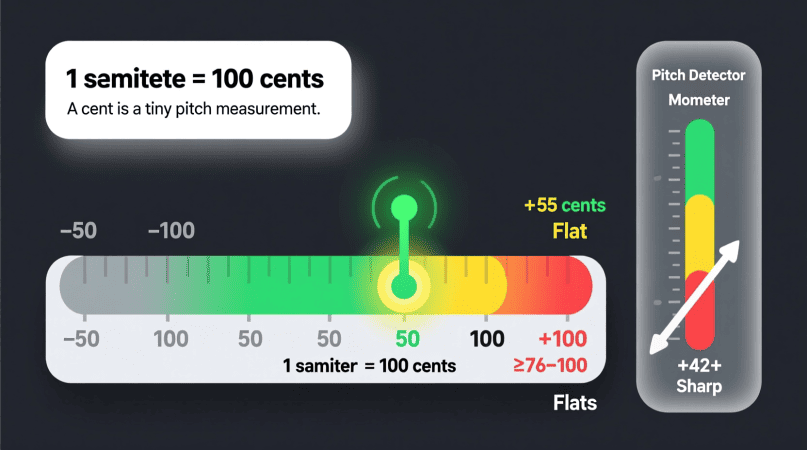
If you’ve ever looked at a tuner and wondered what “+5 cents sharp” really means, you’re not alone. Musicians talk about being “a little flat” or “slightly sharp,” but cents give us a way to measure pitch accuracy precisely. Let’s break down what cents are, how they’re calculated, and why they matter when tuning instruments or training your voice.
The Basics: What Is a Cent?
- A cent is a unit of pitch measurement.
- One semitone (the distance between two adjacent piano keys) is divided into 100 cents.
- There are 1200 cents in an octave.
This system is logarithmic, meaning the size of a cent feels the same no matter if you’re tuning a bass note or a high soprano pitch.
Why Musicians Use Cents
Cents help you understand how close you are to being in tune.
- Instrument tuning – Guitarists, pianists, and violinists can fine-tune beyond just “in tune” or “out of tune.”
- Vocal accuracy – A tool like our Online pitch detector shows exactly how many cents sharp or flat you are.
- Comparing tuning systems – In equal temperament, a major third is 400 cents, while in just intonation it’s ~386 cents. That 14-cent difference explains why chords feel sweeter in some tunings.
How to Calculate Cents
The formula for cents between two frequencies is:
cents = 1200 × log2 (f2 / f1)
- f1f_1 = reference frequency
- f2f_2 = measured frequency
Example:
- Reference note = A4 (440 Hz)
- Measured note = 445 Hz
- 1200×log2(445/440)≈+19.61200 \times \log_2(445/440) \approx +19.6 cents sharp
That’s nearly 20 cents off—clearly noticeable.
How Many Cents Can We Hear?
- 5 cents or less → Hard for most listeners to detect.
- 10 cents → Noticeable to trained ears.
- 20 cents or more → Very noticeable; sounds clearly out of tune.
That’s why most tuners highlight ±10 cents as the “green zone.” Try Our: mp3 pitch analysis online
Equal Temperament vs Just Intonation (in Cents)
| Interval | Equal Temperament | Just Intonation | Difference |
|---|---|---|---|
| Octave | 1200 | 1200 | 0 |
| Perfect Fifth | 700 | 702 | 2 cents |
| Major Third | 400 | 386 | 14 cents |
| Minor Third | 300 | 316 | 16 cents |
These small differences add up, which is why chords can sound slightly different depending on the tuning system.
FAQs About Cents in Tuning
Q: How many cents are in a semitone?
100 cents.
Q: How many cents are in an octave?
1200 cents.
Q: Can humans hear a 5-cent difference?
Most can’t; trained musicians sometimes can.
Q: Why do tuners display cents?
It gives precise feedback, helping players and singers refine their accuracy.
Pitch Detector is a project by Ornella, blending audio engineering and web technology to deliver precise, real-time pitch detection through your browser. Designed for musicians, producers, and learners who want fast, accurate tuning without installing any software.
